
The Amu Darya, also called the Amu, the Amo, and historically the Oxus, is a major river in Central Asia and Afghanistan. Rising in the Pamir Mountains, north of the Hindu Kush, the Amu Darya is formed by the confluence of the Vakhsh and Panj rivers, in the Tigrovaya Balka Nature Reserve on the border between Afghanistan and Tajikistan, and flows from there north-westwards into the southern remnants of the Aral Sea. In its upper course, the river forms part of Afghanistan's northern border with Tajikistan, Uzbekistan, and Turkmenistan. In ancient history, the river was regarded as the boundary of Greater Iran with Turan, which roughly corresponded to present-day Central Asia. The Amu Darya has a flow of about 70 cubic kilometres per year on average.
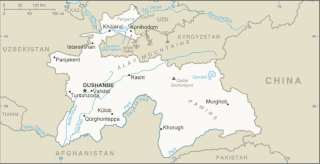
Tajikistan is nestled between Kyrgyzstan and Uzbekistan to the north and west, China to the east, and Afghanistan to the south. Mountains cover 93 percent of Tajikistan's surface area. The two principal ranges, the Pamir Mountains and the Alay Mountains, give rise to many glacier-fed streams and rivers, which have been used to irrigate farmlands since ancient times. Central Asia's other major mountain range, the Tian Shan, skirts northern Tajikistan. Mountainous terrain separates Tajikistan's two population centers, which are in the lowlands of the southern and northern sections of the country. Especially in areas of intensive agricultural and industrial activity, the Soviet Union's natural resource utilization policies left independent Tajikistan with a legacy of environmental problems.

Turkmenistan is a landlocked country in Central Asia, bordering the Caspian Sea to the west, Iran and Afghanistan to the south, Uzbekistan to the north-east, and Kazakhstan to the north-west. It is the southernmost republic of the Commonwealth of Independent States (CIS), the loose federation created at the end of 1991 by most of the Post-Soviet states.
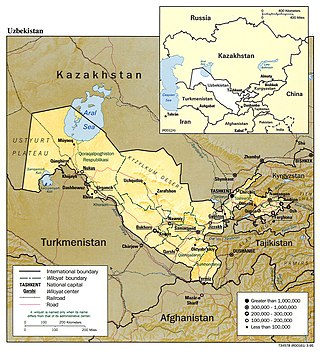
Uzbekistan is a country in Central Asia, located north of Turkmenistan and Afghanistan. With an area of 447,000 square kilometers, Uzbekistan stretches 1,425 km (885 mi) from west to east and 930 km (580 mi) from north to south. It borders Turkmenistan to the southwest, Kazakhstan to the north and Tajikistan and Kyrgyzstan to the south and east. Uzbekistan also has four small exclaves in Turkmenistan.

The Armed Forces of the Republic of Uzbekistan, is the name of the unified armed forces of Uzbekistan, consisting of the Ground Force and the Air and Air Defence forces under the defence ministry. Paramilitary units include the National Guard, a Frontier Service and a River Force. It is reported to be the largest and the strongest in Central Asia.

The Syr Darya, historically known as the Jaxartes, is a river in Central Asia. The name, which is Persian, literally means Syr Sea or Syr River. It originates in the Tian Shan Mountains in Kyrgyzstan and eastern Uzbekistan and flows for 2,256.25 kilometres (1,401.97 mi) west and north-west through Uzbekistan and southern Kazakhstan to the northern remnants of the Aral Sea. It is the northern and eastern of the two main rivers in the endorheic basin of the Aral Sea, the other being the Amu Darya (Jayhun).
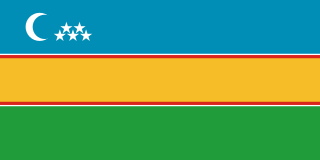
Karakalpakstan, officially the Republic of Karakalpakstan, is an autonomous republic of Uzbekistan. It occupies the whole northwestern part of Uzbekistan. The capital is Nukus. Karakalpakstan covers an area of 166,590 km2 (64,320 sq mi), and a population of about 2 million people. Its territory covers the classical land of Khwarezm, which in classical Persian literature was known as Kāt (کات).
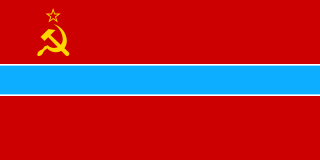
The Uzbek Soviet Socialist Republic, also known as Soviet Uzbekistan, the Uzbek SSR, UzSSR, or simply Uzbekistan and rarely Uzbekia, was a union republic of the Soviet Union. It was governed by the Uzbek branch of the Soviet Communist Party, the legal political party, from 1925 until 1990. From 1990 to 1991, it was a sovereign part of the Soviet Union with its own legislation.

Türkmenabat, formerly Amul, Çärjew, and Novy Chardzhuy, is the second-largest city in Turkmenistan and the administrative centre of Lebap Province. As of 2009, it had a population of approximately 254,000 people. From 1924 to 1927, it was also named Leninsk in honor of Vladimir Lenin.

Termez is the capital of Surxondaryo Region in southern Uzbekistan. Administratively, it is a district-level city. Its population is 182,800 (2021). It is notable as the site of Alexander the Great's city Alexandria on the Oxus, as a center of early Buddhism, as a site of Muslim pilgrimage, and as a base of Soviet Union military operations in Afghanistan, accessible via the nearby Hairatan border crossing.
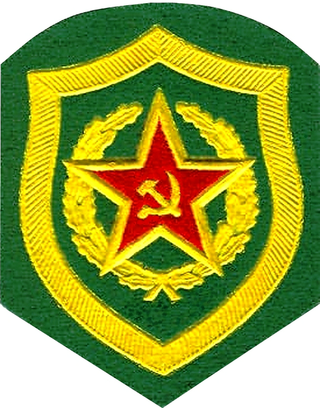
The Soviet Border Troops were the border guard of the Soviet Union, subordinated to the Soviet state security agency: first to the Cheka/OGPU, then to NKVD/MGB and, finally, to the KGB. Accordingly, they were known as NKVD Border Security and KGB Border Troops. Unlike the border guards of many other countries, Soviet Border Troops also included the maritime border guarding units, and aviation units.

A landlocked navy is a naval force operated by a country that does not have a coastline. While these states are unable to develop a sea-going, blue-water navy, they may still deploy armed forces on major lakes or rivers. Such forces are often referred to as brown-water navies.

The Pacific Fleet is the Russian Navy fleet in the Pacific Ocean.

The Project 58150 Gyurza class is a series of small armored gunboats built for the Uzbek Frontier Service. The whole class is produced by the Kuznya na Rybalskomu (Kyiv). The class is named after the Levant viper, Гюрза, Hiurza, in Ukrainian.
Captain 1st rank is a rank used by the Russian Navy and a number of former communist states. The rank is the most senior rank in the staff officers' career group. The rank is equivalent to colonel in armies and air forces. Within NATO forces, the rank is rated as OF-5 and is equivalent to captain in English-speaking navies.
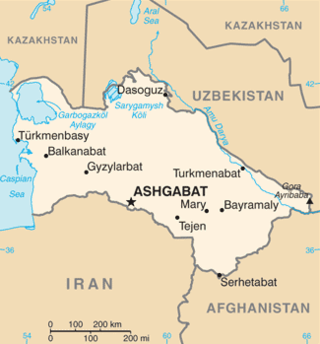
The Afghanistan–Turkmenistan border is 804 km (500 mi) in length and runs from the tripoint with Iran to the tripoint with Uzbekistan.

The Afghanistan–Uzbekistan border is 144 km (89 mi) in length and runs from the tripoint with Turkmenistan to the tripoint with Tajikistan along the Amu River. It is the shortest of Uzbekistan's external borders. The city of Termez in Uzbekistan and the town of Hairatan in Afghanistan are the closest major populated centers to the border.
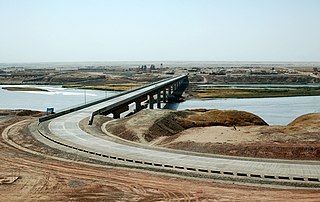
The Afghanistan–Tajikistan border is 1,357 km (843 mi) in length and runs from the tripoint with Uzbekistan in the west to the tripoint with China in the east, almost entirely along the Amu Darya, Pyanj and Pamir Rivers, except for the easternmost section along the Wakhan Corridor and divides the Tajik community in two.

These two Asian nations of Afghanistan and Uzbekistan share a border and have some cultural ties. Northern Afghanistan is home to an estimated 3.5 million ethnic Uzbeks, the second-largest Uzbek population behind only Uzbekistan. Afghanistan also has a native dialect of the Uzbek language that, while using a different alphabet, is fully mutually intelligible with the Uzbek spoken in Uzbekistan. However the Uzbek language only has legal status in Uzbek majority provinces and no national government of Afghanistan has ever given official status to the Uzbek language.
The Red Banner Central Asian Border District was a district of the Soviet KGB Border Guards. It had its headquarters in Ashgabad. It guarded the Afghan-Soviet and the Iranian-Soviet border. The sea border of the district extended halfway along the southern line of Soviet territorial waters in the Caspian Sea until it met the terrain of the Red Banner Trans-Caucasus Border District.






























